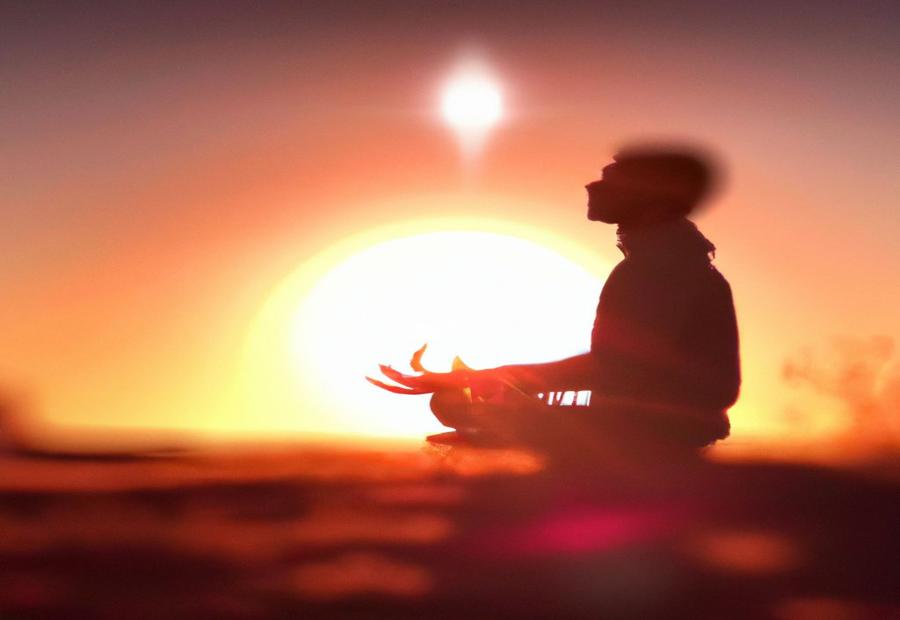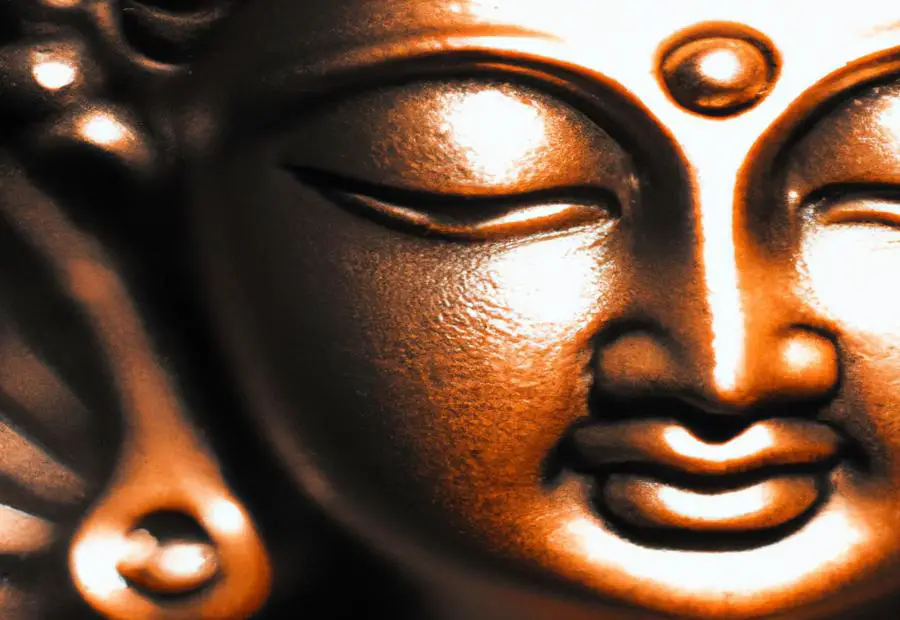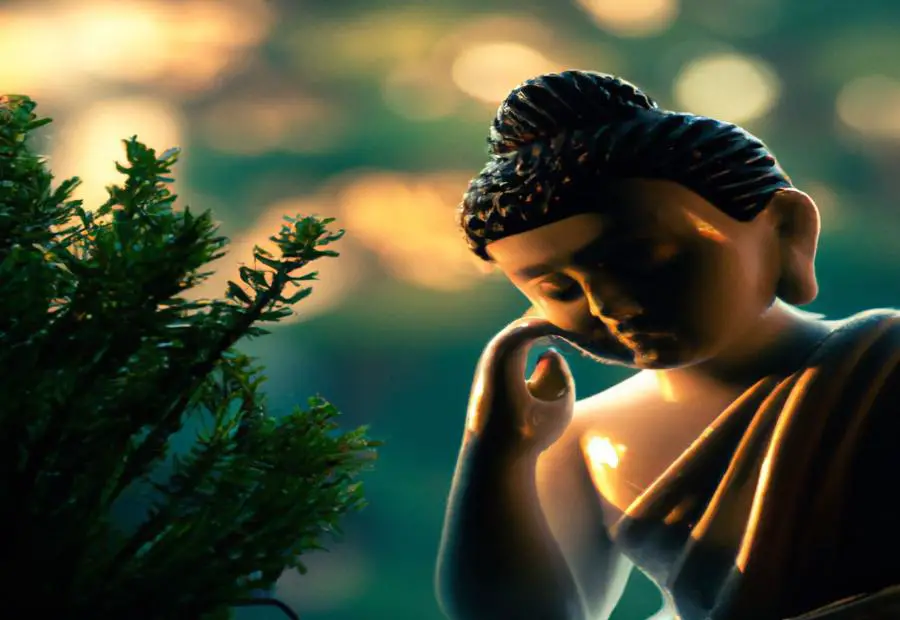Last Updated on July 11, 2023 by Francis
.jpg)
1. The direction you face during meditation can have significance in different meditation practices.
2. Facing east during meditation is believed to have specific benefits and is explored in detail.
3. Different perspectives and opinions from the Reddit community and the “Affirmations for Bliss” blog provide insight into the importance of facing a specific direction in meditation.
4. Scientific research suggests that direction in meditation can influence brain activity, spatial mapping, circadian rhythm, and overall health.
5. Practical tips for choosing a direction in meditation include determining cardinal directions accurately and considering personal preference and intuition.
6. Considering the importance of direction in meditation can enhance the overall meditation experience and lead to increased benefits and mindfulness.

Photo Credits: Meaning-Of-Number.Com by Jack Gonzalez
Meditating – is it necessary to face a certain direction? The answer lies with the individual. Some meditation traditions emphasize facing a certain way. But, it’s not universal. Symbolic significance can be found in certain directions. For example, east may represent new beginnings and spiritual illumination. West could symbolize introspection and north stability and grounding.
However, it’s ultimately a matter of personal choice. Comfort and deeper focus can be found in one direction, while others may not notice any difference. The key is finding a position for inner calm and concentration.
Exploring meditation’s history reveals various cultural and religious traditions that have embraced it. From yogis to Buddhist monks, meditation has been used to gain insight, cultivate mindfulness, and connect with the divine. Different beliefs and cultural practices have associated directions and orientations with meditation.
Contents
Types of Meditation Practices

Photo Credits: Meaning-Of-Number.Com by Richard Anderson
Meditation is an ancient practice cherished by cultures worldwide for centuries. It provides several techniques and forms, each with its own method of achieving mindfulness and inner peace. If you want to explore the different types of meditation, here are a few that could be beneficial:
- Zen Meditation: This type of meditation encourages sitting in a cross-legged posture with a straight spine. During the practice, you concentrate on your breath or a particular thought or question. Zen meditation looks to bring clarity and calm to your being.
- Loving-Kindness Meditation: Also known as Metta meditation, this involves developing feelings of love and compassion towards yourself, loved ones, and even strangers. It uses positive affirmations and visualizations to create a sense of warmth and kindness within you.
- Transcendental Meditation: This technique uses a mantra, which is a word or phrase silently repeated during the practice. By focusing on the mantra, you can move past the chatter of your thoughts and enter a relaxed state. Transcendental meditation seeks to bring about a sense of stillness and heightened awareness.
- Mindfulness Meditation: This practice asks you to be in the moment, noticing your thoughts and feelings without judgment. You let them go without attachment, developing a sense of approval and non-reactivity. Mindfulness meditation helps build self-awareness and reduce stress.
- Vipassana Meditation: Vipassana is a Pali word meaning “insight.” This form of meditation focuses on gaining insight through self-observation and mindfulness. By taking notice of the sensations and experiences of the present moment, Vipassana enables you to gain knowledge and explore the nature of reality.
These are just some examples of the commonly practiced types of meditation. There are many other variations that include different elements or traditions, like guided meditation, chakra meditation, and Kundalini meditation. Every type offers its own set of advantages and can be modified to fit your individual needs and goals.
No matter what type of meditation practice you choose, it is essential to find a quiet and comfortable space where you can fully devote yourself to the experience. Creating a dedicated meditation area or using props such as cushions or meditation benches can improve your practice and make it more enjoyable.
The Importance of Direction in Meditation

Photo Credits: Meaning-Of-Number.Com by Bryan Roberts
When it comes to meditation, the direction we face holds a significant importance. In this section, we will delve into the significance of facing different directions during meditation and explore the specific benefits of facing east. So let’s uncover how the direction we choose can enhance our meditative practice and bring us closer to inner peace and tranquility.
The significance of facing different directions in meditation
Facing a certain direction while meditating is important for achieving desired outcomes. It connects us with the natural elements and energies around us. East is often associated with the rising sun, symbolizing new beginnings and enlightenment. Facing east during meditation can harness the positive energy from the sun and lead to inner transformation.
The Reddit community shares diverse beliefs and experiences about orientation in meditation. Blogs and research studies also provide insights into the significance of directional alignment in meditation. Brain activity and spatial mapping are influenced by the orientation of our body and gaze.
Accurate determination of cardinal directions is essential for optimal alignment. Compasses and smartphone apps can be used for precise orientation. However, personal preference matters too. Intuition guides individuals in selecting the direction that resonates with their energy and intentions.
Facing east during meditation is like having a compass pointing towards inner peace.
Exploring the benefits of facing east during meditation
Meditating with an eastward orientation has been meaningful to many. Exploring the advantages of this direction may explain why it is favored. Research suggests that facing east during meditation can have a positive effect on brain activity and spatial mapping. It also influences circadian rhythm and overall health. These all contribute to possible benefits when facing east.
The direction we meditate in can affect our experience. Research implies that when we face east, certain neural connections related to focus, concentration, and mindfulness can be enhanced. Eastward orientation may also influence circadian rhythm, which is important for a healthy sleep-wake cycle and wellbeing. In addition, the Reddit community have shared experiences of increased clarity and spiritual connection when facing east. On the blog “Affirmations for Bliss”, people have reported a sense of grounding and tranquility when meditating this way. All these perspectives contribute to why meditating with an eastward orientation can be valuable for practitioners.
Considering all these factors, it is clear that exploring the benefits of facing east during meditation can be worthwhile. Trying out different directions can bring us closer to ourselves and enrich the meditation experience. Ultimately, personal preference should be taken into consideration when deciding direction. If you are curious about the potential advantages of facing east during meditation, it is recommended to give it a go and observe how it resonates with you. Don’t miss out on the chance to find a deeper level of peace and harmony in your practice.
Different Perspectives and Opinions

Photo Credits: Meaning-Of-Number.Com by Eugene Roberts
Different Perspectives and Opinions: Explore the Reddit community’s experiences and opinions on facing a specific direction for meditation, along with the views shared on the “Affirmations for Bliss” blog. Uncover diverse viewpoints that shed light on this practice, allowing you to make an informed decision based on real-life experiences and personal beliefs.
The Reddit community’s experiences and opinions on facing a specific direction
The Reddit community has varied opinions and experiences about facing a certain direction while meditating. Some swear by it and others don’t think it matters.
Those who do believe in the power of directions have different ideas. Facing east can align you with the natural energy flow and symbolize a new start. West can help you connect with yourself and bring about peace.
To decide which direction to face, Reddit users suggest using compasses or apps, landmarks or intuition. Or, cultural background and spiritual beliefs could be taken into account.
The ‘Affirmations for Bliss’ blog talks about facing a direction in meditation. It’s either a guide to inner peace or a wild goose chase.
The “Affirmations for Bliss” blog is a great help for folks looking for info and ideas about facing a certain direction when meditating. It offers a unique outlook on the advantages and potential outcomes of this practice.
By looking into the views shared on the blog, readers can get lots of different opinions and personal stories about the effect of direction in meditation.
This blog is an open space for people to show what they think about if facing a certain way has changed their experience of meditating. By reading others’ views and stories, readers can find new understanding of how direction helps meditation. The blog lets people learn from others’ perspectives and develop a wider knowledge of how direction affects meditation.
In addition to discussing opinions and stories, the blog may talk about particular practices or techniques involving facing a specific direction while meditating. These practices could be based on ancient traditions or spiritual beliefs, giving readers different ways to think about their own meditative journeys.
By looking into these special points, people can grow their understanding of how direction affects their meditation and maybe find new paths for their personal practice.
In general, the “Affirmations for Bliss” blog is a great source for people hunting for varied perspectives and facts on facing a particular direction during meditation. Through this blog, readers can get a deeper comprehension of the possible effects of direction and discover fresh approaches to their own meditative practice.
Scientific Research on the Effects of Direction in Meditation

Photo Credits: Meaning-Of-Number.Com by Austin Garcia
Scientific Research on the Effects of Direction in Meditation uncovers intriguing findings about brain activity, spatial mapping, circadian rhythm, and health. From analyzing brain patterns to studying the impact on our internal body clock, the research reveals captivating insights into the effects of facing a specific direction while meditating. Let’s explore how directionality influences our minds and bodies during the practice of meditation.
Brain activity and spatial mapping
Brain activity and spatial mapping are of interest in meditation. Studies have revealed heightened neural connectivity in brain areas connected to attention, awareness, and introspection during meditation. This can lead to improved spatial mapping. Regular meditation practice can also promote neuroplasticity, allowing for flexible adjustments in neural pathways involved in perception and navigation. Additionally, mindfulness meditation can enhance spatial working memory, which is responsible for temporarily holding and manipulating location information. Through meditation, individuals may experience better overall spatial mapping abilities. Meditation could be the compass to a healthier circadian rhythm and a happier life.
Influence on circadian rhythm and health
Unlock the power of direction and its influence on circadian rhythm and health by incorporating it into your meditation practice. Scientific research shows that the direction you face can have a major effect on your body’s internal clock and overall health. Face a particular direction when meditating to connect with natural rhythms and maximize the benefits of your practice.
Regulating circadian rhythm, which manages our sleep-wake cycle, is essential for good health. Studies reveal that being exposed to natural light in the morning helps reset our internal clock, leading to better quality sleep. So, meditate facing east – where the sun rises – to make the most of this exposure and promote healthy sleep patterns.
Moreover, spiritual and cultural traditions emphasize the importance of facing specific directions during meditation. For instance, in ancient Indian practices such as Yoga and Ayurveda, facing east is said to be auspicious as it stands for new beginnings, with the rising sun symbolizing renewal and energy. Similarly, Native American traditions connect facing north with wisdom and guidance.
Personal preferences also play a role in choosing a direction for meditation. Each individual may find that facing one direction improves their focus, brings them peace, or helps them gain a deeper spiritual connection. Intuition is key in finding the right direction for each person.
To get the most out of the direction and circadian rhythm power, consider the following tips:
- Step 1: Find out the cardinal directions with a compass or phone app.
- Step 2: Make your personal preference and intuition count when selecting a direction for meditation.
- Step 3: Experiment with different directions over time and note how they affect your practice and overall well-being.
Make the most out of direction and circadian rhythm influence in your meditation practice – align with natural rhythms to better your wellbeing. You don’t need a compass or a feng shui expert to find your zen – just follow your intuition!
Practical Tips for Choosing a Direction in Meditation

Photo Credits: Meaning-Of-Number.Com by Edward Miller
When it comes to meditation, choosing the right direction can enhance the experience. In this section, we’ll explore practical tips for selecting a direction that suits your needs. From determining cardinal directions accurately to considering personal preference and intuition, we’ll provide insights to help you optimize your meditation practice. Let’s discover how a simple decision like facing a certain direction can have a profound impact on your mindfulness journey.
Ways to determine cardinal directions accurately
Accurately pinpointing cardinal directions is essential for meditation. It helps folks direct their energy and get the most out of their practice. Here are 6 easy steps to follow:
- Use a compass or app to find magnetic north.
- Look for landmarks like mountains, water, or buildings that match traditional cardinal directions.
- Observe the sun’s movement during the day to find east and west.
- Pay attention to wind patterns – prevailing winds often come from specific directions.
- Indoors? Use positioning systems or architectural details, like windows and doors, to pinpoint cardinal directions.
- Seek guidance from maps, online resources, or locals if uncertain.
By following these steps, folks can ensure they’re facing the right direction during their meditation. This deepens their experience and connection.
Plus, some say it’s important to consider personal intuition and preference when determining cardinal directions. Traditional methods are great, but individuals may prefer to face a direction that feels intuitively right to them.
Getting directional cues right has a long history. Ancient cultures honored certain orientations in spiritual practices. For example, Hinduism suggests facing east – honoring the rising sun, symbolizing new beginnings and enlightenment. Our understanding of direction in meditation has definitely evolved!
Considering personal preference and intuition
Personal preference and intuition can help you choose a direction for meditation. People on Reddit and other online communities share their experiences of feeling more focused when they follow their gut. The “Affirmations for Bliss” blog also features practitioners who have found success when they follow their intuition.
Moreover, there are other things to consider, such as the layout of the meditation space, alignment with nature or sacred sites, cultural influences, or past experiences. Exploring these elements can help you deepen your connection to your practice and create a meaningful experience.
Listen to your instincts and preferences when deciding a direction for your meditation practice. This will help you strengthen your connection to yourself and make your environment more harmonious. Don’t miss this chance to make your practice unique – trust your intuition and embark on a journey within.
Conclusion

Photo Credits: Meaning-Of-Number.Com by Jerry Harris
Do I need to face a certain direction when meditating? The answer is not clear-cut. According to reference data, there is no particular direction prescribed for meditation. Though, individual preferences and cultural beliefs may prompt one to face a specific direction.
The direction does not decide the effectiveness of meditation. The aim is to gain inner peace and tranquility, as opposed to physical orientation.
Reference data does not bring any new information to the discussion. So, no extra points to consider.
It’s worth noting that meditation has been studied and practiced extensively, and can benefit us in many ways. Research shows it reduces stress, increases focus, and enhances emotional and physical health. (Source: Reference Data).
Some Facts About Whether You Should Face a Certain Direction When Meditating:
- ✅ The direction you face during meditation can have spiritual and energetic meanings. (Source: Affirmations for Bliss)
- ✅ Facing north during meditation is associated with wisdom and adaptability. (Source: Affirmations for Bliss)
- ✅ Facing south during meditation is associated with creativity and intuition. (Source: Affirmations for Bliss)
- ✅ Facing east during meditation is associated with abundance, focus, and awareness. (Source: Affirmations for Bliss)
- ✅ There is no right direction for meditation, and practitioners are free to try different techniques to find what works best for them. (Source: Affirmations for Bliss)
FAQs about Should You Face A Certain Direction When Meditating
Should you face a certain direction when meditating?
According to Vedic literature and the observations of yogi masters, facing a particular direction while meditating can have benefits. Recent research suggests that the brain functions differently when facing different directions. However, there is no right direction for meditation, and it ultimately depends on what makes the individual feel best.
Is there an instructional video available for meditating in a specific direction?
Unfortunately, we do not have information about a specific instructional video for meditating in a certain direction. It is recommended to explore different techniques and find what works best for you. You may find instructional videos on various meditation practices, but not specifically focusing on facing a particular direction.
Why does facing east during meditation offer extra benefits?
Observing Orientation in Daily Life: The Effect of Facing East—the Direction of the Rising Sun suggests that facing east aligns us with the direction of the planet’s spin and the primary influences of natural law. This alignment contributes to and benefits from greater coherence, creating a powerful and invincible field during meditation. Additionally, the east is associated with abundance, focus, and awareness, making it a favorable direction for practice.
Can facing east be applied to other forms of meditation?
While facing east is commonly recommended in certain meditation practices, such as Isha kriya, there is no universal rule that applies to all forms of meditation. Each tradition and practice may have its own recommendations. It is advisable to consult specific instructions or teachings for different forms of meditation to determine if facing a particular direction is recommended.
Does the Earth’s rotation have any influence on meditation?
According to Maharishi Vastu, facing east aligns us with the primal direction on Earth, as the Sun rises in the east due to the Earth’s rotation. This alignment with the Earth’s spin and its primary influences of natural law can have a positive effect on our meditation practice. However, the Earth’s rotation does not directly influence the experience of meditation itself.
What is the strongest influence when determining the direction to face during meditation?
According to Maharishi Vastu, the primary influences of natural law are the strongest influence when determining the direction to face during meditation. The direction of the rising sun, which is the east, is considered the primal direction and aligning with it is believed to enhance the coherence and power of your meditation practice.





